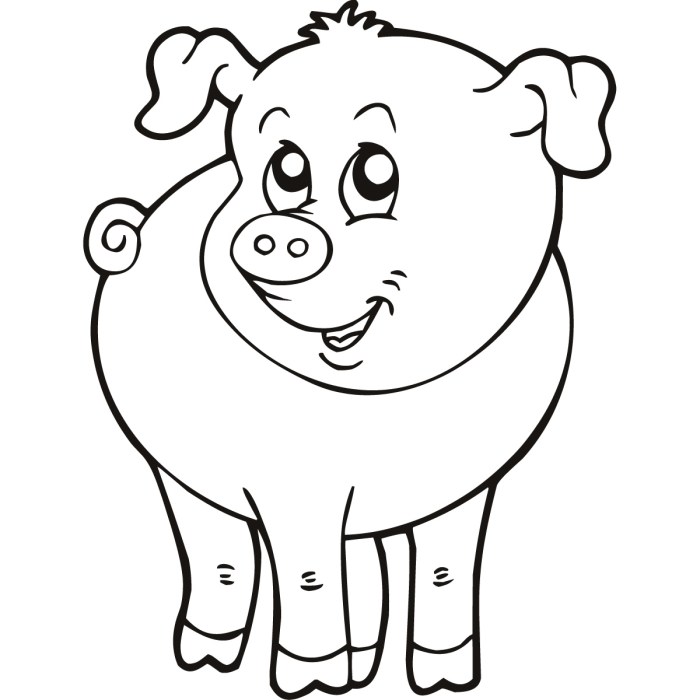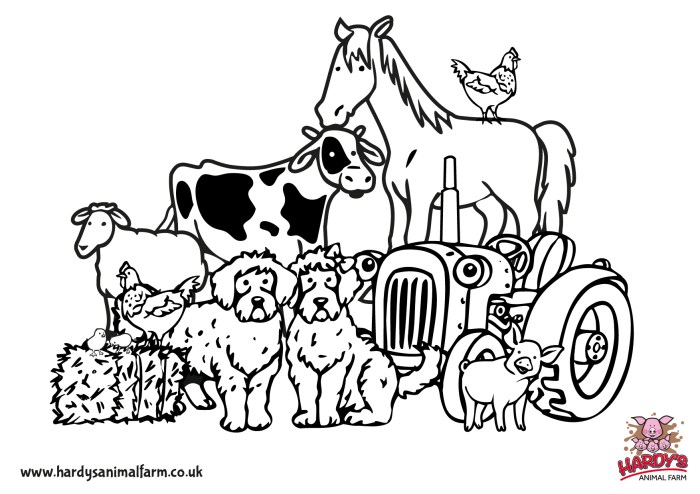Illustrative Descriptions of Farm Animals for Coloring Pages

Farm animals to coloring – Right then, so we’ve got the intro and outro sorted, brilliant. Let’s crack on with some descriptive text for those colouring pages, shall we? We need to make them engaging for little tykes, you know, the sort who’d rather wrestle a piglet than do their spellings.
Pig Coloring Page Description
This cheeky pig is having a right old time rooting around in the mud! He’s got a curly tail, little pink trotters, and a snout that’s always sniffing for tasty treats. His skin is a lovely pinkish-grey, and he’s surrounded by lush green grass and maybe a few juicy apples. He’s probably just had a good roll in the mud, so his coat’s a bit mucky, but that just makes him even more adorable.
He’s looking happy as Larry, ready for a snooze in the sunshine after his muddy adventure. Give him some vibrant colours and make him really pop!
Horse Coloring Page Description
This magnificent horse stands tall and proud, a real picture of elegance and power. Its coat is a deep, glossy chestnut, shimmering in the sunlight. Its long, flowing mane and tail ripple gently in the breeze. Its legs are strong and muscular, showing its incredible strength and stamina. Notice its intelligent eyes and the way it holds its head high.
Imagine it galloping across a wide, open field, its hooves barely touching the ground. This majestic creature is a symbol of freedom and grace. Use a range of colours to bring out its beauty.
Comparison of Descriptive Language
Right, so comparing the two descriptions, we can see a pretty clear difference in tone and vocabulary. The pig description is playful and informal, using words like “cheeky,” “muddy,” and “adorable.” It focuses on the pig’s playful actions and endearing features. The language is simple and easily understood by young children. The horse description, on the other hand, is more formal and sophisticated, using words like “magnificent,” “elegant,” and “majestic.” It emphasizes the horse’s strength, grace, and beauty.
The vocabulary is slightly more advanced, but still accessible to children, evoking a sense of awe and wonder. The overall tone is one of admiration and respect for the animal’s power and elegance. Basically, one’s all “oink oink” fun, the other’s all “neigh” majestic grace.
Variations in Farm Animal Depictions for Coloring Pages: Farm Animals To Coloring

Choosing the right artistic style for farm animal coloring pages is, like, totally crucial for engaging young artists. The style significantly impacts the overall aesthetic appeal and the ease with which children can colour the images. Different styles cater to different developmental stages and artistic preferences. This section will explore three distinct artistic styles and their implications for depicting a chicken, a classic farm favourite.
Cartoon Style Chicken Depictions, Farm animals to coloring
A cartoon style prioritizes simplification and exaggeration for a fun, playful aesthetic. Think bright, bold colours, simplified shapes, and exaggerated features. A cartoon chicken might have comically large eyes, oversized feet, and a simplified body shape, perhaps resembling a plump, cheerful ball with stick legs. The lines would be bold and clear, making it easy for even the youngest children to stay within the lines and colour effectively.
The simplicity reduces frustration, fostering a positive colouring experience and encouraging creativity. The challenge lies in maintaining a recognisable chicken form while simplifying its features, but the benefit is that it’s super accessible and encourages a sense of fun and accomplishment.
Realistic Style Chicken Depictions
A realistic style aims for accuracy and detail, showcasing the chicken’s anatomy and plumage in a more lifelike manner. A realistic chicken would have intricate feather details, accurately rendered beak and comb, and a more complex body shape. The colour palette would be more nuanced, with variations in shading and tone to create depth and dimension. While challenging for younger children who might struggle with fine motor skills and detailed colouring, this style offers an opportunity to learn about observation and detail.
The reward is a finished product that looks incredibly lifelike, providing a sense of achievement once completed. The complexity, however, could be quite daunting for younger children.
Whimsical Style Chicken Depictions
A whimsical style blends elements of fantasy and reality, creating a charming and imaginative depiction. A whimsical chicken might have vibrant, unusual colours, exaggerated features like a fluffy tail or sparkly eyes, and perhaps be incorporated into a fantastical setting, like a flower garden or a fairytale landscape. This style allows for greater creative freedom and can encourage children’s imagination.
The challenge lies in balancing the whimsical elements with a recognisable chicken form, preventing the image from becoming too abstract or confusing. The benefit is that it encourages imaginative play and fosters creativity. It’s a great middle ground between the stark simplicity of the cartoon style and the intricate detail of the realistic style.
Expanding the world of farm animal coloring pages, consider the broader spectrum of adorable creatures. For a wider selection of delightful subjects, check out these coloring pages pets animals , offering everything from playful puppies to majestic cats. Returning to farm animals, remember that the simple act of coloring can help children learn about different breeds and species.
